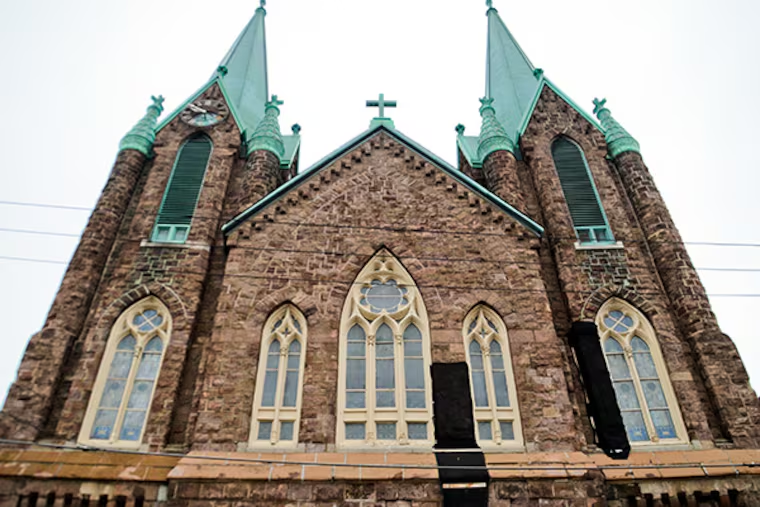Developers explore demolition of Fishtown’s St. Laurentius, citing dangerous conditions at beloved church
An engineer’s report submitted to the city’s Department of Licenses and Inspections urges that St. Laurentius be demolished as soon as possible.

Developers who agreed to buy St. Laurentius Church in Fishtown are exploring the option of demolishing the historic church, a move that could end a years-long battle over the fate of the 1880s property, long considered a hallmark of the river wards’ skyline.
An attorney for the development team submitted an engineer’s report to the Department of Licenses and Inspections on Monday urging that St. Laurentius be taken down as soon as possible, a city spokesperson said. L&I Commissioner David Perri is reviewing the report, which is based at least partially on a Sept. 18 inspection by the engineer, but no determination has been made.
The city declined to share the report with The Inquirer, citing an ongoing legal review to determine what portions can be shared with the public. According to one city spokesperson, the report has been provided to both L&I and the Historical Commission.
The report’s submission provides at least a partial glimpse into the deteriorating state of the former Roman Catholic church as well as the developers’ intentions for the property. Since stones tumbled from the building two times this year — the second incident, in May, sent 6,000 pounds of rock flying — it’s been unclear whether the years-long plans to redevelop the church could be salvaged.
In a statement Wednesday, developer Leo Voloshin downplayed the possibility of razing the building, saying that while “we explored the possibility of demolition due to the concerning reports that our engineer provided us, our mission continues to be to find a way to save the structure.”
He added that “we are hoping to close in the next 30 days and begin the work as soon as possible.”
St. Laurentius has stood at Berks and Memphis Streets since 1882, when it was built with donations collected by Fishtown’s struggling Polish immigrants. Today, it shares a block with St. Laurentius Catholic School and is surrounded by rows of houses. At least twice this year, the school was forced to close as the falling stones crashed through scaffolding.
Concerns surrounding the safety of St. Laurentius have swirled for years, prompting the Archdiocese of Philadelphia in 2014 to close and deconsecrate the building, citing “vertical cracks” and heavy deterioration that put parts of the church at risk of collapse. A year later, church officials announced that St. Laurentius would be demolished. L&I said that year that it had deemed the building unsafe. A separate 2015 engineer’s report said that a portion of the church was a “significant safety hazard" and that “further deterioration may lead to a large-scale masonry failure.”
The archdiocese’s announcement that it would demolish St. Laurentius faced massive resistance from preservationists and residents, who viewed the church as a community mainstay. They fast-tracked an effort to have the building declared historic; in 2015, Philadelphia granted St. Laurentius preservation status, protecting it from demolition.
In the years following, Voloshin, partnering with Philadelphia-based Linden Lane Capital Partners, came forward with a proposal. They would purchase the property and redevelop St. Laurentius into apartments, while preserving the church’s exterior and keeping its iconic towers standing. Many residents celebrated the idea. A smaller group, called the Faithful Laurentians, argued that more should be done to restore the church’s interiors and murals.
For years, the Faithful Laurentians blocked the development team from moving forward, through a series of lawsuits that came to an end this year. Weeks later, City Council voted to change the zoning of the land under St. Laurentius to help clear a path for redevelopment.
But amid the legal delays, St. Laurentius continued to deteriorate. This year, Voloshin said the costs to save it had escalated. Still, he said in May that he was committed to trying to preserve the church, still owned by the archdiocese in trust for the Fishtown-based Holy Name of Jesus Parish, which merged with the St. Laurentius parish.
After stones tumbled from the building in May, the city ordered the archdiocese to stabilize the building. Roughly $135,000 was spent over the summer to do so, said Karen Guss, L&I spokesperson. In August, an engineer working for the archdiocese informed L&I that “in his professional judgment, the building had been stabilized,” Guss said.
The report submitted to the city this week depicts a bleaker situation and indicates that St. Laurentius is in dangerous condition, Guss said. However, she added that it is unclear whether the repairs by the archdiocese were taken into account.
“So the department is figuring out next steps, which will likely be getting an evaluation of what is going on with that building right now," Guss said. But, she added, “L&I inspectors were out at the building after the receipt of the report, and in their judgment, there doesn’t need to be an emergency demolition.”
Voloshin’s statement Wednesday did not say which developers remained involved in the project.
Earlier this month, a spokesperson for the Archdiocese of Philadelphia said that the sale of St. Laurentius had been expected to settle last Friday. The spokesperson did not return calls or an email this week.